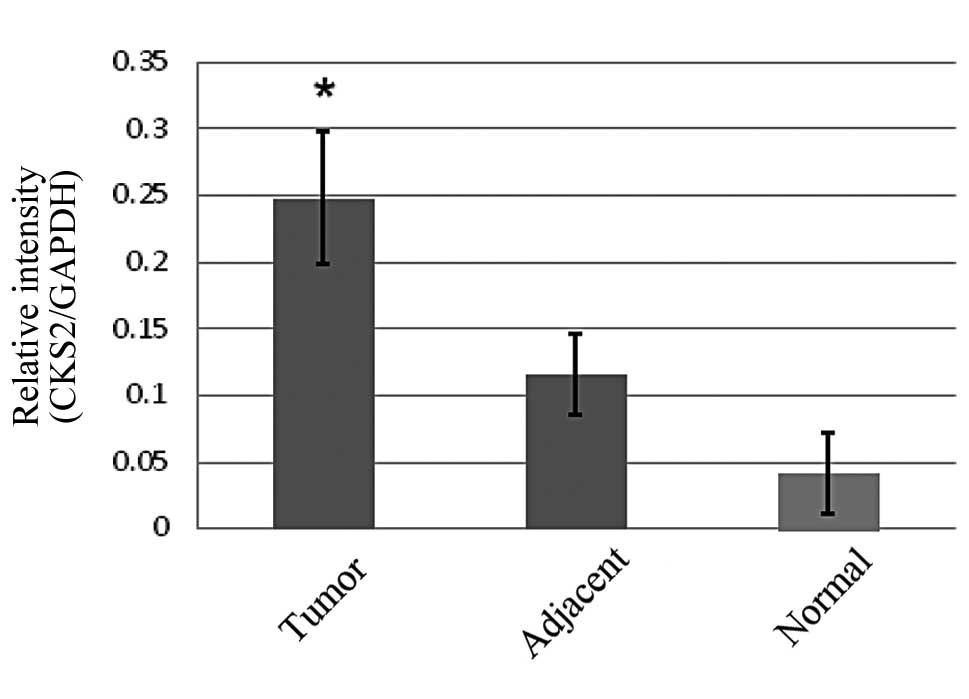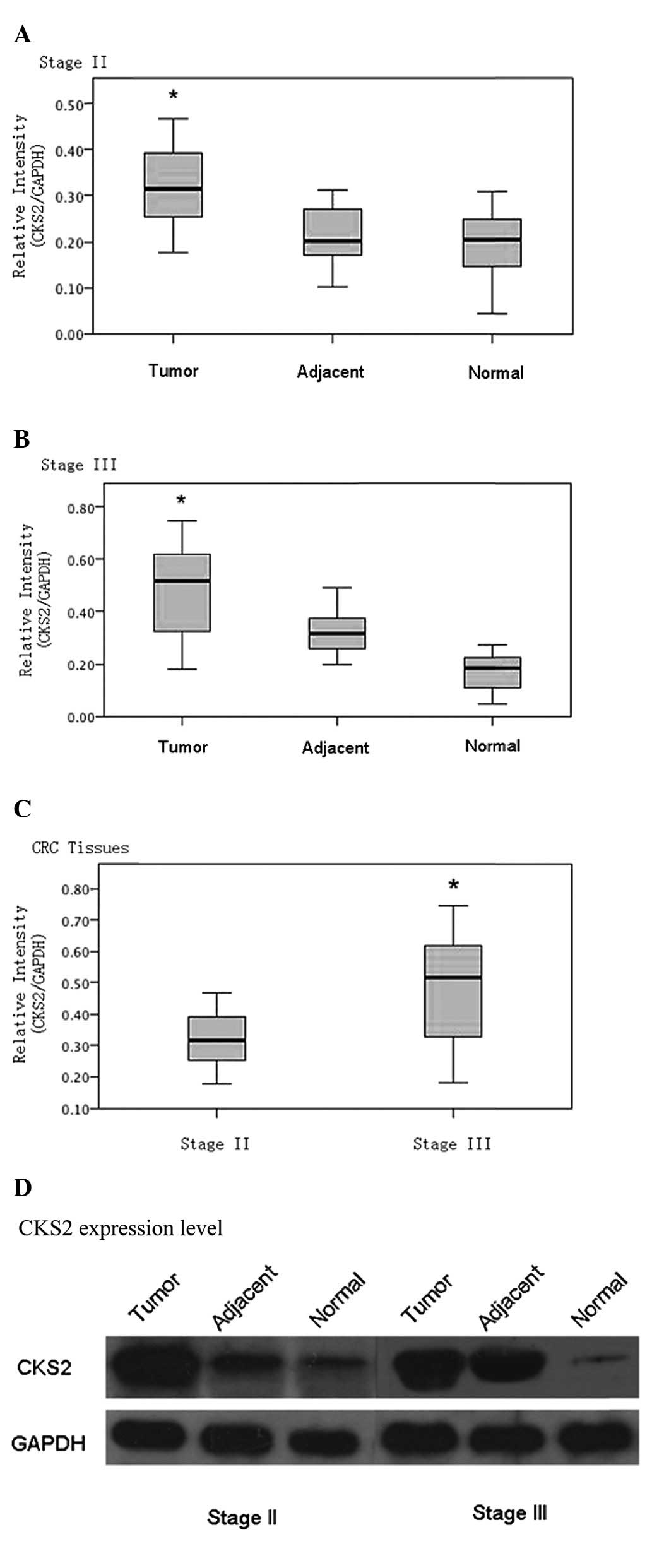Expression and clinical significance of cyclin kinase subunit 2 in colorectal cancer
- Authors:
- Published online on: July 11, 2013 https://doi.org/10.3892/ol.2013.1456
- Pages: 777-780
Abstract
Introduction
Colorectal cancer (CRC), one of the most common primary malignancies, demonstrates molecular heterogeneity during its development and progression (1). The prognosis of patients with CRC is commonly determined by traditional clinicopathological factors, including tumor grade and lymph node status (2,3). Nevertheless, patients may have significantly different clinical outcomes despite the exhibition of similar clinicopathological features (4). Although serum carcinoembryonic antigen (CEA) has long been regarded as the most significant and common biomarker for CRC, there are limitations to the sole use of the CEA level for the early diagnosis and prognosis of CRC (5). Therefore, the identification of novel gene expression that is altered in CRC may aid the understanding of the mechanisms of tumorigenesis, the development of diagnostic biomarkers, the prediction of the clinical prognosis and the design of targeted therapies.
The cyclin kinase subunit (CKS) proteins, which consist of CKS1 and CKS2 in vertebrates, are highly conserved molecules in eukaryotes. These proteins share 81% amino acid sequence homology (6). The overexpression of CKS1 has been demonstrated to be correlated with poor survival rates in patients with breast, colorectal, prostate and renal cancer (7–10). There is accumulating evidence that CKS2 expression, similar to that of CKS1, is upregulated in a variety of malignant tumors, including those of the prostate, bladder and liver (10–12). However, whether CKS2 is overexpressed in CRC remains unclear.
The present study aimed to show that CKS2 expression was significantly upregulated in CRC, and that it was correlated with certain clinical features of CRC. The results suggested that the expression level of CKS2 may have a diagnostic and prognostic value for patients with CRC.
Materials and methods
Patients and specimens
As approved by the ethics committee of Renji Hospital (Shanghai Jiaotong University School of Medicine, Shanghai, China), colorectal cancer samples were obtained from 30 patients who underwent routine surgery for CRC at the Department of Surgery between 2010 and 2012. Patients were recruited immediately following surgery and samples of CRC, adjacent non-cancer and normal colorectal tissues were collected at that time. None of the patients had received any pre-operative treatment, including radiation or chemotherapy. Clinical data were recorded and the pathological classification was performed according to a staging system previously described (2). The tissues were immediately placed in TRIzol reagent for the extraction of RNA and protein. Written informed consent was obtained from all patients.
RNA extraction and quantitative (q)PCR analyses
Tissues were lysed and the total RNA was isolated using TRIzol reagent (Invitrogen Life Technologies, Carlsbad, CA, USA), according to the manufacturer’s instructions. Following quantification of the RNA, a sample containing 2 μg RNA was annealed to the oligo(dT) at 65°C for 5 min and cooled at −4°C for 2 min. A total volume of 20 ml was used for the reverse transcription (RT) reaction; this contained RT-buffer, RNasin, reverse transcriptase, dNTPs and RNA-oligo(dT) mixtures. The PCR reaction was conducted at 42°C for 60 min, and the following primers were used: CKS2 forward, 5′-GCTCTTCGCGCTCTCGTTTCATTT-3′ and reverse, 5′-ACTCTGTTGGACACCAAGTCTCCT-3′. The PCR reactions were terminated subsequent to 35 cycles. For the PCR quantitation, the SYBR, primers and cDNA were mixed, and the reaction was performed for 40 cycles using the MJ Research PTC-l00 Thermal Cycler system (Bio-Rad, Hercules, CA, USA). The data were normalized with the glyceraldehyde3-phosphate dehydrogenase (GAPDH) housekeeping gene. All primers were custom-synthesized by Sangon Biotech (Shanghai) Co., Ltd. (Shanghai, China).
Western blot analysis
The total protein was extracted from ~0.5 g frozen tissue using radioimmunoprecipitation assay (RIPA) buffer (Beyotime, Shanghai, China). Aliquots containing 30 mg protein were subjected to sodium dodecyl sulfate-polyacrylamide gel electrophoresis and electroblotted onto a polyvinylidene difluoride membrane (Amersham Biosciences AB, Uppsala, Sweden) for western blot analyses for 2 h. Following incubation with 5% skimmed milk for 2 h, the membranes were incubated with the primary antibody [anti-CKS2, dilution of 1:3,000 in Tris-buffered saline and 0.1% Tween 20 (TBST)] for 1 h at room temperature. Each membrane was then washed three times with TBST for 10 min followed by incubation with the secondary antibody goat anti-mouse IgG-HRP (Santa Cruz Biotechnology Inc., Santa Cruz, CA, USA) (1:10,000–30,000 dilution) for 1 h. Following three 10-min washes with TBST, the specifically bound antibodies were detected with the Enhanced Chemiluminescence (ECL) kit (MultiScience Biotech Co., Shanghai, China), according to the manufacturer’s instructions. The intensity of the bands was quantified usign the Tanon GIS system (Tanon, Shanghai, China) and the data were normalized to the GAPDH loading controls.
Statistical analysis
All data were processed with SPSS 13.0 software (SPSS, Inc., Chicago, IL, USA). The Kruskal-Wallis non-parametric test was used to analyze the correlations between CKS2 mRNA expression and various clinicopathological features. P<0.05 was considered to indicate a statistically significant difference, and was calculated by the two-tailed test.
Results
Correlations between CSK2 expression and clinicopathological features
The clinical findings are summarized in Table I. A total of 14 males (46.7%) and 16 females (53.3%), with ages ranging between 27 and 81 years (median, 62 years; mean, 58.7 years) were recruited into the study. Thirteen patients presented with rectal cancer and 17 with colon cancer. The post-operative pathological classifications were performed according to the NCCN Guidelines Version 2.2012, and included 15 patients (50.0%) each in stages I and II.
Expression of CKS2 is elevated at the mRNA and protein levels in CRC
To determine whether CKS2 was overexpressed in CRC, the mRNA and protein levels of CKS2 were measured in the tumor and adjacent non-tumor tissues, as well as in the normal colorectal tissue. qPCR analyses revealed that the mRNA levels of CKS2 were significantly increased in the CRC tissue compared with the adjacent non-tumor and normal colorectal tissues (Fig. 1). Western blot analyses demonstrated that the expression of the CKS2 protein was also upregulated in the CRC tissue samples, as shown in Fig. 2.
Overexpression of CKS2 is correlated with the aggressive behavior of CRC
To further examine the clinicopathological relevance of CKS2 overexpression in CRC, CKS2 expression was analyzed in correlation with pathological features of tumors. The results revealed that the overexpression of CKS2 at the protein level was significantly correlated with tumor size, differentiation and pathological tumor node metastasis (pTNM) stage (Table I). No significant correlation was detected between CKS2 overexpression and other clinicopathological features, such as patient age and gender or tumor location.
Discussion
The CKS proteins, including CKS1 and CKS2, are essential components of cyclin/cyclin-dependent kinase (CDK) complexes that are involved in the regulation of cell cycle progression. The CKS proteins exhibit 81% amino acid sequence identity (13). The dysregulation of the CKS proteins and other cell cycle-related regulators, including the cyclins and CDKs, has been demonstrated to be associated with several types of tumors (14,15).
The present study identified that CKS2 was overexpressed at the mRNA and protein levels in CRC tissues in comparison with the adjacent non-cancer and normal colon tissues. However, the opposite was observed in certain samples. This may occur in clinical practice due to the lack of a clear definition of the adjacent non-tumor tissue. Furthermore, these data clearly demonstrated that the overexpression of CKS2 was significantly correlated with tumor differentiation and lymph node metastasis, which may have contributed to the development of CRC. However, as the complete course of the CRC patients was not available, a Kaplan-Meier survival analysis could not be conducted.
Although the level of CKS2 expression was significantly higher in the tumor tissue than in the adjacent non-cancer and normal colorectal tissues, there were certain discrepancies in the correlation between CKS overexpression at the mRNA and protein levels and lymph node metastasis. These discrepancies may be attributed to the relatively small sample size in the present study. Different translation efficiencies or stabilities of the protein in the tumor tissues may also have caused the discrepancies in the results. In addition, genetic and epigenetic factors, including DNA methylation, genetic mutation and abnormal post-transcriptional regulation, may have contributed to the variation in the results (16). Further studies are required to clarify this issue.
In conclusion, to the best of our knowledge, this is the first study to demonstrate that CKS2 is overexpressed in CRC. The results suggested that the aberrant expression of CKS2 may contribute to the development and progression of CRC, and that CKS2 expression patterns may be of diagnostic and prognostic value for CRC patients.
References
|
Hanahan D and Weinberg RA: The hallmarks of cancer. Cell. 100:57–70. 2000. View Article : Google Scholar | |
|
Edge SB: AJCC Staging Manual. 7th edition. Springer; New York, NY: 2010 | |
|
Le Voyer TE, Sigurdson ER, Hanlon AL, et al: Colon cancer survival is associated with increasing number of lymph nodes analyzed: a secondary survery of intergroup trial INT-0089. J Clin Oncol. 21:2912–2919. 2003. | |
|
Siena S, Sartore-Bianchi A, Di Nicolantonio F, et al: Biomarkers predicting clinical outcome of epidermal growth factor receptor-targeted therapy in metastatic colorectal cancer. J Natl Cancer Inst. 101:1308–1324. 2009. View Article : Google Scholar : PubMed/NCBI | |
|
Chu DZ, Erickson CA, Russell MP, et al: Prognostic significance of carcinoembryonic antigen in colorectal carcinoma. Serum levels before and after resection and before recurrence. Arch Surg. 126:314–316. 1991. View Article : Google Scholar : PubMed/NCBI | |
|
Williams RT, Wu L, Carbonaro-Hall DA, et al: Identification of a novel cyclin-like protein in human tumor cells. J Biol Chem. 268:8871–8880. 1993.PubMed/NCBI | |
|
Slotky M, Shapira M, Ben-Izhak O, et al: The expression of the ubiquitin ligase subunit Cks1 in human breast cancer. Breast Cancer Res. 7:R737–R744. 2005. View Article : Google Scholar : PubMed/NCBI | |
|
Shapira M, Ben-Izhak O, Linn S, et al: The prognostic impact of the ubiquitin ligase subunits Skp2 and Cks1 in colorectal carcinoma. Cancer. 103:1336–1346. 2005. View Article : Google Scholar : PubMed/NCBI | |
|
Lan Y, Zhang Y, Wang J, et al: Aberrant expression of Cks1 and Cks2 contributes to prostate tumorigenesis by promoting proliferation and inhibiting programmed cell death. Int J Cancer. 123:543–551. 2008. View Article : Google Scholar : PubMed/NCBI | |
|
Liu Z, Fu Q, Lv J, Wang F and Ding K: Prognostic implication of p27Kip1, Skp2 and Cks1 expression in renal cell carcinoma: a tissue microarray study. J Exp Clin Cancer Res. 27:512008. View Article : Google Scholar : PubMed/NCBI | |
|
Kawakami K, Enokida H, Tachiwada T, et al: Identification of differentially expressed genes in human bladder cancer through genome-wide gene expression profiling. Oncol Rep. 16:521–531. 2006.PubMed/NCBI | |
|
Kang MA, Kim JT, Kim JH, et al: Upregulation of the cycline kinase subunit CKS2 increases cell proliferation rate in gastric cancer. J Cancer Res Clin Oncol. 135:761–769. 2009. View Article : Google Scholar : PubMed/NCBI | |
|
Shen DY, Fang ZX, You P, et al: Clinical significance and expression of cyclin kinase subunits 1 and 2 in hepatocellular carcinoma. Liver Int. 30:119–125. 2009. View Article : Google Scholar : PubMed/NCBI | |
|
Alhasan SA, Ensley JF, Sarkar FH, et al: Genistein induced molecular changes in a squamous cell carcinoma of the head and neck cell line. Int J Oncol. 16:333–338. 2000.PubMed/NCBI | |
|
Hansel DE, Dhara S, Huang RC, et al: CDC2/CDK1 expression in esophageal adenocarcinoma and precursor lesions serves as a diagnostic and cancer progression marker and potential novel drug target. Am J Surg Pathol. 29:390–399. 2005. View Article : Google Scholar | |
|
Martinsson-Ahlzén HS, Liberal V, Grünenfelder B, et al: Cyclin-dependent kinase-associated proteins Cks1 and Cks2 are essential during early embryogenesis and for cell cycle progression in somatic cells. Mol Cell Biol. 28:5698–5709. 2008. |











